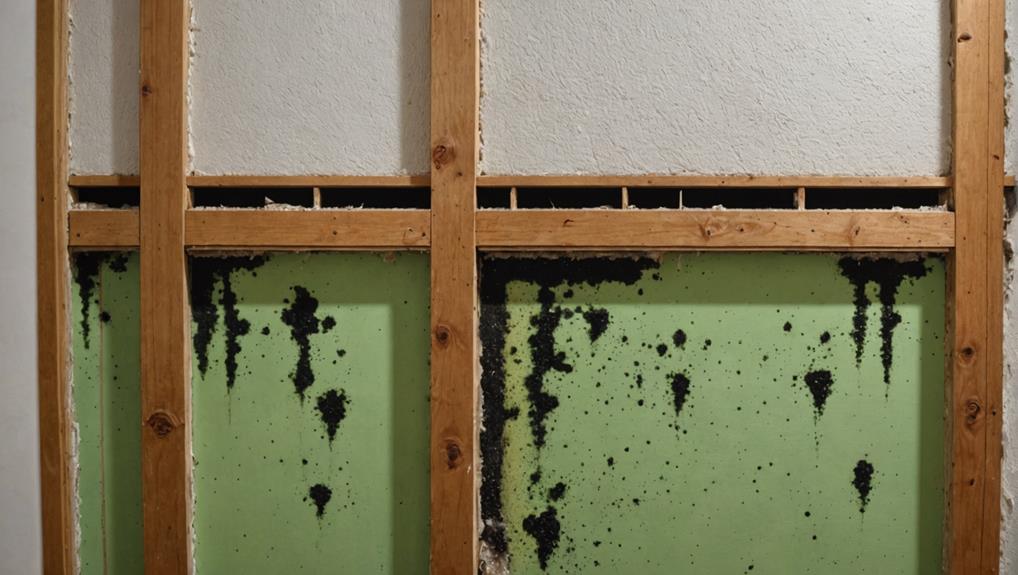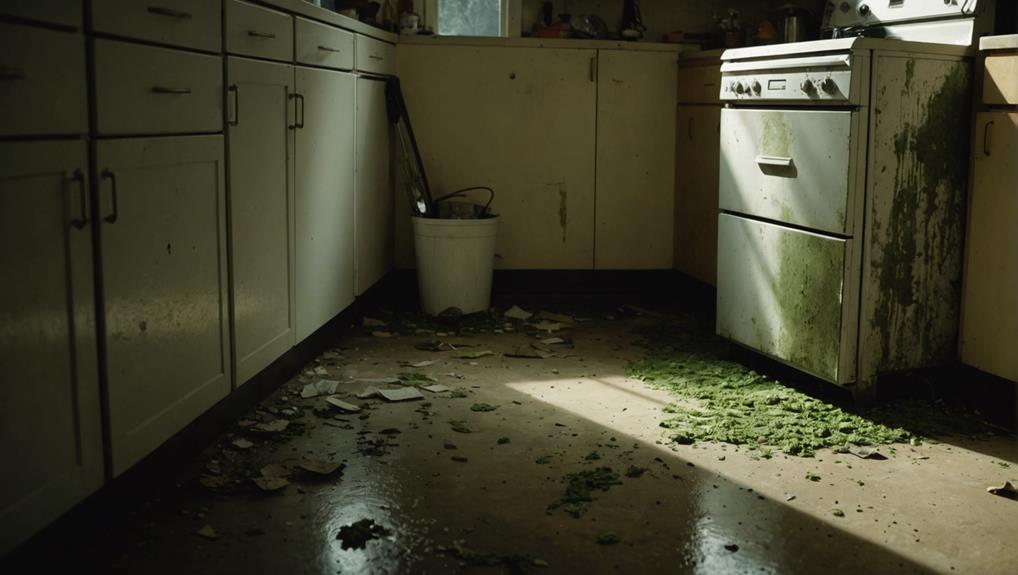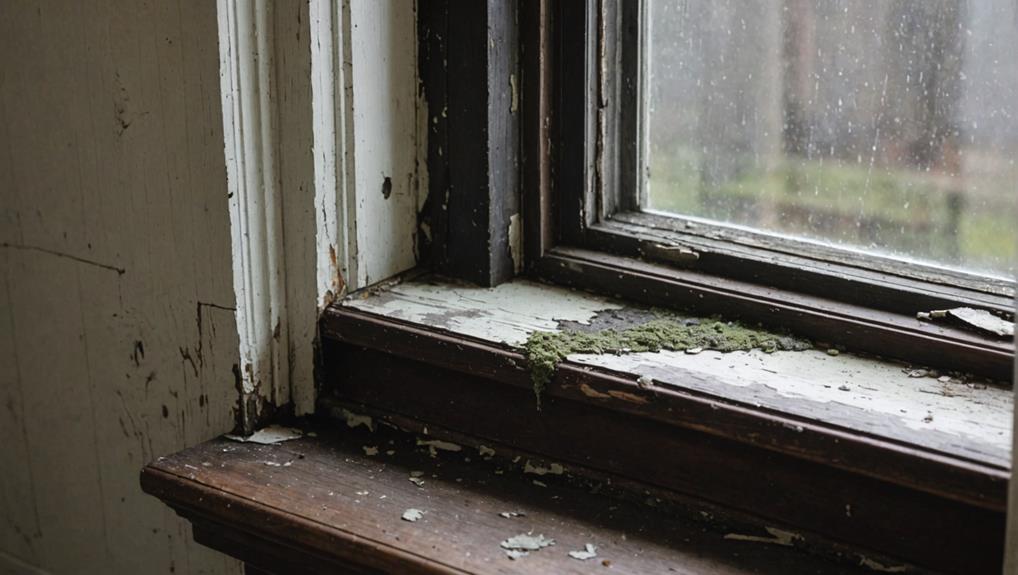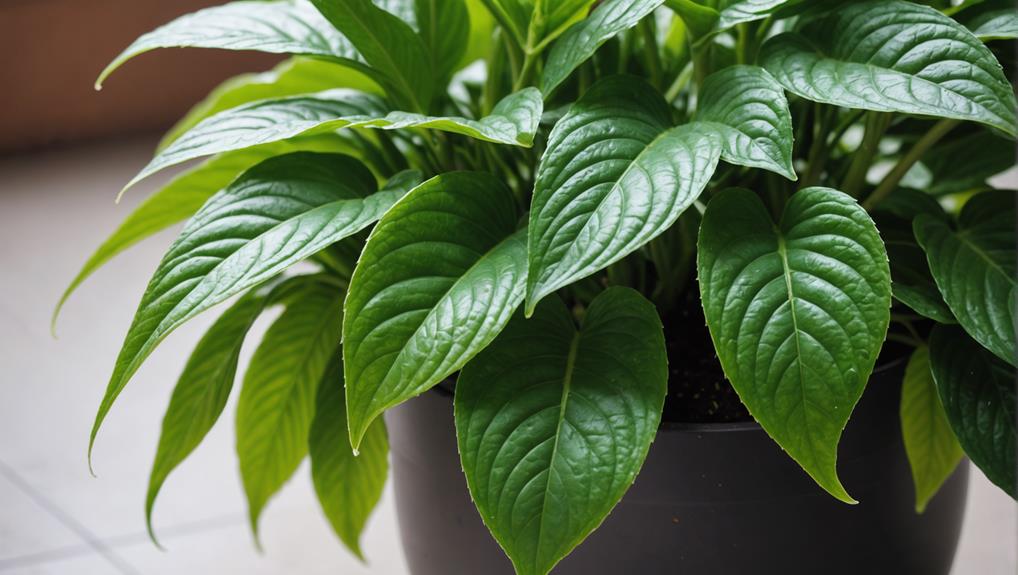Mold can hide in surprising places throughout your home. You might find it inside your walls, where leaks create damp conditions. Underneath your carpet is another risky area, as it can trap moisture. Check behind kitchen appliances, where hidden hoses may leak. Your laundry room is likewise a prime spot because of heat and humidity. Don't overlook windows and doors; condensation can lead to mold growth around seals. Inside air ducts, poor maintenance can encourage buildup. Even houseplants can be culprits if their soil is overly moist. Uncovering these hidden dangers can be essential for a healthier living space.
Inside Your Walls

Have you ever considered what might be lurking inside your walls? It's vital to recognize that wall cavities offer a perfect environment for mold growth, often fueled by hidden leaks. These leaks can stem from plumbing issues or roof leaks, creating moisture-rich conditions that mold thrives in.
Typically, you won't see any signs of trouble from the outside. Nevertheless, if you're proactive, you can uncover these hidden threats before they escalate. Perform regular inspections, especially after heavy rain or plumbing repairs. Pay attention to any unusual dampness or water stains on walls, as these can signal potential leaks behind the surface.
It's critical to understand that mold doesn't just compromise structural integrity; it can additionally impact your health and that of your loved ones. If you suspect moisture accumulation in your wall cavities, consider employing a professional to conduct a thorough investigation. They can utilize advanced tools to detect hidden leaks and identify any mold growth that may be occurring out of sight. Taking swift action now can save you significant time, money, and stress in the long run. Your vigilance is your best ally in maintaining a mold-free home.
Underneath Your Carpet
Carpets can be more than just a cozy addition to your home; they can likewise harbor hidden dangers, particularly mold. If you've experienced leaks or high humidity, moisture can become trapped beneath your carpet, creating an ideal environment for mold growth. Regular carpet cleaning isn't just about aesthetics; it's a vital step in maintaining a healthy living space.
To effectively combat hidden mold, consider implementing moisture detection techniques. Identifying damp areas before they become a serious issue is important for preventing mold proliferation.
Here's a quick reference table to help you understand the risks and solutions associated with mold under your carpet:
| Risk Factors | Detection Methods | Preventive Measures |
|---|---|---|
| High humidity levels | Moisture detection tools | Use dehumidifiers |
| Water leaks | Visual inspections | Regular carpet cleaning |
| Poor ventilation | Humidity monitoring | maintain proper airflow |
| Old or damaged carpets | Professional testing | Replace if necessary |
Behind Kitchen Appliances

Behind your kitchen appliances, hidden moisture can accumulate unnoticed, creating an ideal environment for mold growth. Poor ventilation in these areas aggravates the issue, trapping humidity and preventing proper air circulation. Regularly checking behind your appliances is crucial to identify and address any moisture issues before they escalate.
Hidden Moisture Accumulation
In the often-overlooked spaces behind kitchen appliances, hidden moisture accumulation can create an ideal breeding ground for mold. This environment can stem from various sources, compounding the risk of mold growth. Addressing these issues requires a keen eye and proactive measures.
Consider the following potential moisture sources:
- Appliance Hoses: Check your refrigerator and dishwasher hoses for leaks. A small drip can lead to significant moisture buildup.
- Crawl Space: If your kitchen is over a crawl space, humidity from below can seep up, especially if the area lacks proper ventilation.
- Plumbing Issues: Leaky pipes within walls may not be visible but can lead to substantial mold growth behind appliances.
- Basement Humidity: High humidity levels in the basement can affect your kitchen, especially if there's inadequate roof drainage or foundation cracks that allow moisture ingress.
It's crucial to regularly inspect these hidden spaces. Ignoring them can lead to not just mold issues but furthermore long-term structural damage, affecting your home's integrity and your health. Stay vigilant to maintain a mold-free kitchen environment.
Poor Ventilation Areas
Kitchen spaces often harbor areas of poor ventilation, particularly behind appliances where airflow is restricted. This lack of airflow creates an environment favorable to mold growth. When you neglect the spaces behind your refrigerator, dishwasher, or oven, you may inadvertently trap moisture, allowing mold spores to flourish.
Consider the common sources of moisture in your home, like basement humidity or excessive crawl space dampness. These factors can worsen the problem, especially when combined with inadequate attic ventilation or ineffective bathroom exhaust systems. If your kitchen isn't equipped with ceiling fans or other ventilatory measures, stagnant air can lead to mold hiding behind appliances, where it remains undetected.
To combat this, regularly clean and inspect these areas. Verify that your kitchen's ventilation systems are operational and effective. Investing in proper ventilation can dramatically reduce the risk of mold proliferating in hard-to-reach areas. By being proactive and vigilant, you can maintain a healthier kitchen environment and assert control over potential mold problems that threaten your home's integrity.
In the Laundry Room
Many homeowners may not realize that the laundry room can be a prime location for mold growth due to its warm, humid environment. The combination of moisture from washing clothes and insufficient ventilation creates an ideal breeding ground for mold spores, particularly around significant appliances and supplies.
To effectively combat mold in your laundry room, consider these important areas:
- Washing Machine: Mold can thrive in the rubber gaskets and detergent dispensers. Regularly clean these components to prevent buildup.
- Laundry Detergent: Liquid detergent containers can leak, creating damp spots. Verify these are sealed properly and stored in a dry location.
- Dryer Vent: Confirm the dryer vent is clear and properly vented to the outside, as trapped moisture can encourage mold growth.
- Folding Surfaces: Any surfaces where damp clothes are folded can retain moisture. Wipe these surfaces dry after each use.
Around Windows and Doors

Windows and doors often serve as overlooked entry points for mold growth owing to the condensation that can accumulate in these areas. When humidity levels rise, moisture can gather around window seals and door frames, creating the ideal environment for mold spores to thrive. This is particularly true in climates with significant temperature fluctuations, where the warm, moist air inside meets the cooler surfaces of glass and frames.
You might not notice the problem immediately, as mold can develop in hidden spots, like the corners of window frames or behind the trim of doors. Regularly inspect these areas, focusing on the integrity of window seals and the condition of door frames. A compromised seal not only allows moisture to seep in but likewise permits drafts, further exacerbating the issue.
To mitigate mold growth, confirm that window seals are intact and replace any damaged seals promptly. For door frames, consider using moisture-resistant materials or applying sealants to create a barrier against humidity. Taking these proactive measures can empower you to maintain a healthier living environment and prevent the costly consequences of mold infestations.
Inside Air Ducts
Air ducts can easily become another hidden reservoir for mold, particularly if they're not regularly maintained. Poor duct maintenance can lead to moisture accumulation, providing an ideal environment for mold to thrive. This not only compromises air quality but can likewise affect your health and comfort in your home.
To guarantee your air ducts remain mold-free, consider these crucial steps:
- Regular Inspections: Schedule routine checks to identify any signs of mold or moisture buildup.
- Professional Cleaning: Engage a qualified technician to clean your ducts every few years, particularly if you notice a musty odor.
- Humidity Control: Maintain indoor humidity levels below 60% to deter mold growth. A dehumidifier can be beneficial in damp areas.
- Seal Leaks: Inspect for and seal any leaks in ductwork to prevent moisture intrusion, which can promote mold.
On Houseplants and Soil

Houseplants can greatly improve the aesthetic appeal of your home, but they can likewise be a hidden source of mold if not properly cared for. Maintaining ideal plant care is crucial to prevent mold growth. Excess soil moisture and poor watering frequency can create an environment ripe for mold, especially in decorative pots that may not allow adequate drainage.
Pay attention to indoor humidity levels, as overly humid conditions can worsen mold issues. Regularly inspect your plants for pest problems, which can contribute to plant diseases that further weaken their defenses against mold.
Utilizing effective repotting techniques can help refresh soil that may be harboring mold spores. Here's a quick reference table to guide you in maintaining a healthy indoor garden:
| Aspect | Recommended Practice |
|---|---|
| Soil Moisture | Keep slightly moist, not soggy |
| Watering Frequency | Adjust based on season and plant |
| Indoor Humidity Level | Maintain 40-60% for ideal growth |
Conclusion
In the battle against mold, your home can be both a sanctuary and a hidden threat. While you might feel safe in your living spaces, it's essential to remember that mold often lurks in unexpected places. From the cozy warmth of your walls to the dampness of your laundry room, vigilance is key. By understanding where mold hides, you can protect your home and health, ensuring that comfort doesn't come at the cost of your well-being.
